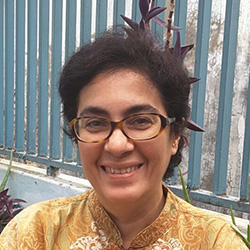EAST KALIMANTAN ‘AHEAD OF THE CURVE’
In a workshop jointly organised by CIFOR and East Kalimantan Plantation Office, on the Indonesia side of Borneo- palm oil producers, waste management companies, NGOs and local government representatives came together to discuss if a circular bio-based economy is viable.
What is agreed by all of those in attendance is the benefits of growing the domestic bioenergy sector. APROBI highlights that in 2017, emission reduction from biodiesels already reached nearly seven million tonnes of CO2, even though current output is shooting well below capacity. For scale, that is the equivalent to 18 percent of Indonesia’s national emission reduction target in the energy and transport sector.
So why is the crops bioenergy potential so grossly under-explored? Perhaps the most substantive outcome of the workshop was the lack of clarity between the parties.
Currently the price of energy produced by the biomass plant and sold to the grid has not been defined: the electricity companies, bioenergy producers and Ministry of Energy are at odds with its value. According to Dermawan, building bioenergy plants come with high start-up costs. To instil confidence in the long-term investment, a pricing plan needs to be defined.
What’s more, at local government level there is a shared belief that the responsibility of bioenergy development lays firmly with central government.
This is at odds with what the national government says. Indonesia’s provincial governments are required to have a Regional Energy Plan (Rencana Umum Energi Daerah, or RUED) and develop their own region’s bioenergy sector.
In a recently published working paper, CIFOR scientists laid out the opportunities and challenges with existing policies that are related to the development of palm oil–based biodiesel; inconsistency between national and subnational responsibilities was among the leading identified barriers.
Download the working paper (Bahasa only): Pengembangan bioenergi di Indonesia
According to the paper, the national Agriculture Minister’s Regulation No 11/2015, and provincial regulation in East Kalimantan, East Kalimantan Governor’s Regulation No. 35/2015, already provide guidelines for harnessing liquid waste from palm oil mills. However, they don’t seem to have been effective in accelerating the development of renewable energy in this province, says Dermawan.
“Indonesia is a country with over 17,000 islands, of which 2,400 are inhabited. Putting good national policies into practice across the archipelago will not happen overnight.”
In some ways, East Kalimantan is ahead of the curve. It has already formulated its RUED based on 2015 data, and is currently integrating bioenergy in its mid-term development plan. In September 2017, East Kalimantan governor, Prof. Dr. Awang Faroek Ishak, along with heads of its regional districts jointly committed to conserving 640,000 hectares of forest and 50,000 hectares of peatlands .
“Bioenergy production cannot grow while existing policies do not support one another,” said Dermawan. His team at CIFOR is exploring ways to guide through existing regulations that can be used to accelerate the expansion of the bioenergy sector.
“This could provide job opportunities, make palm oil more productive, and fight the poverty-energy trap”
TURNING WASTE INTO MONEY
Henny Herdiyanto, who leads the Sustainable Plantation Development Unit at the East Kalimantan Plantation Office welcomes more companies to process their waste to power for their own use, or sell their excess power to surrounding communities through the National Electricity Company (PLN).
As it stands, only five companies out of 80 operating in the province are doing this.
REA Kaltim Plantations is one of the five. It claims it has saved IDR25 billion (USD 1.7 million) annually from avoided diesel fuel purchases. They also sell their excess power to PLN and claim to supply power to nearly 7,000 households in two surrounding districts.
To Herdiyanto, the collaborative workshop is only the start of his commitment to making East Kalimantan a self-sufficient province in electricity. “I invite more palm oil companies to invest in producing electricity, or work together with companies that specialize in processing waste to energy,” he says.
Indeed bioenergy development is currently dominated by big actors. Creating opportunities to build a model for small scale businesses could not only pave the way for a more equitable energy market, but could be the most practical solution in bringing energy to Indonesia’s most remote areas.
“On one hand, companies are reluctant to develop infrastructure because they are waiting for the availability of the electricity grid, but on the other hand, PLN is reluctant to develop their electricity grid because of uncertain levels of demand,” Dermawan stresses.
He says that developing palm oil by-products for energy should be considered for remote areas, especially as the current mainstream grid is not set up to do this. Dermawan is excited by the opportunity.
“There is opportunity for innovation,’ he says. It’s difficult not to catch his enthusiasm when he talks of small-scale community run electricity initiatives, including those off-grid . “This could provide job opportunities, make palm oil more productive, and fight the poverty-energy trap,” he concludes.
Download the working paper (Bahasa only): Pengembangan bioenergi di Indonesia
Download also: Exploring the potential of bioenergy in Indonesia for multiple benefits
The original headline ‘Can palm oil shake its bad boy image and enter the circular economy’ was changed 01.08.2019
This research was supported by Federal Ministry of Economic Cooperation and Development (BMZ)
Copyright policy:We want you to share Forests News content, which is licensed under Creative Commons
Attribution-NonCommercial-ShareAlike 4.0 International (CC BY-NC-SA 4.0). This means you are free to redistribute our material for non-commercial purposes. All we ask is that you give Forests News appropriate credit and link to the original Forests News content, indicate if changes were made, and distribute your contributions under the same Creative Commons license. You must notify Forests News if you repost, reprint or reuse our materials by contacting
forestsnews@cifor-icraf.org.























